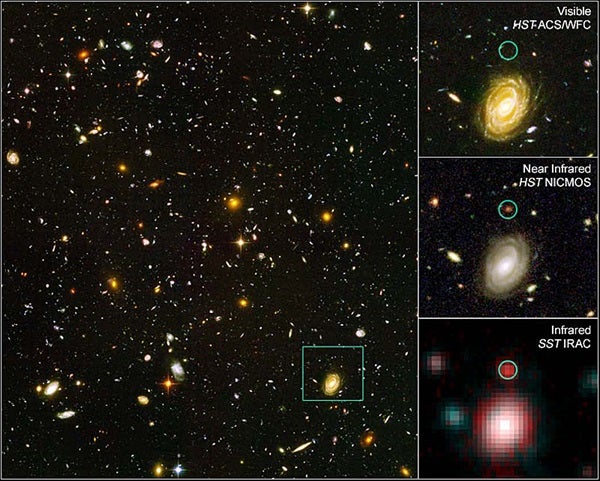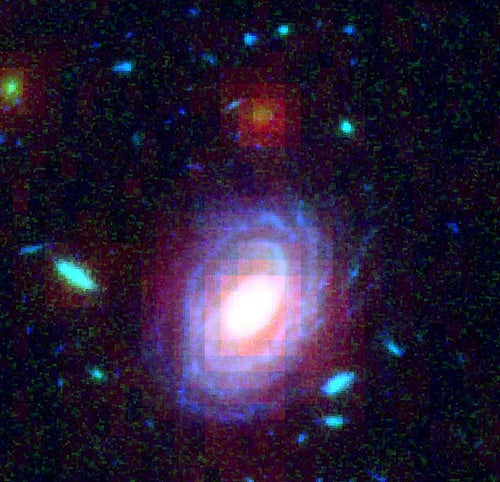Astronomers using NASA’s Spitzer and Hubble space telescopes have found a massive galaxy seen when the universe was only 800 million years old. They found the object in the Hubble Ultra Deep Field (HUDF), a patch of sky in the constellation Fornax where Hubble has acquired the deepest-ever portrait of the cosmos in visible and near-infrared wavelengths.
“This galaxy, named HUDF-JD2, appears to have ‘bulked up’ amazingly quickly, within the first few hundred million years after the Big Bang,” says Bahram Mobasher, an astronomer at Baltimore’s Space Telescope Science Institute and the European Space Agency and leader of the discovery team. “It made about 8 times more mass in stars than is found in our own Milky Way today, and then, just as suddenly, it stopped forming new stars.”
“We are looking back to when the universe was only 6 percent of its present age,” says Richard Ellis, an astronomer at the California Institute of Technology and a member of the discovery team. “This is truly a significant object.”
Astronomers believe the galaxy is among the most distant measured, lying between redshifts 6 and 7.5. The galaxy’s large mass and maturity come as a surprise because cosmologists believe early galaxies were small fragments — building blocks that later gathered to form today’s galactic giants. What’s more, HUDF-JD2 appears to have closed its star-making factories, which means the bulk of its star formation must have occurred even earlier.
“If the distance measurement to this object holds up to further scrutiny, the fact such a galaxy has already completed its star formation implies a yet-earlier period of intense activity,” notes Ellis. “There is now every reason to search beyond this object for the cosmic dawn, when the first such systems switched on.”
Instead, the team estimated the distance to HUDF-JD2 indirectly by looking at its energy at different wavelengths. “It’s not quite as convincing as a spectrum, and we estimate a 75-percent chance that we have the right distance,” Ellis tells Astronomy. “There’s no real prospect of getting a more accurate distance with current facilities.”
To study HUDF-JD2, the 30-person team used data from Hubble, Spitzer, the Keck II Telescope in Hawaii, the Gemini South Telescope and the European Southern Observatory’s Very Large Telescope (VLT), both in Chile . The astronomers discovered the object by looking for “J-band dropouts.” These are objects whose light at an observed wavelength of 1 micron can’t be detected because blue light emitted by their stars — and shifted to the infrared as the universe expanded — was absorbed by intergalactic clouds of hydrogen gas in the early universe.
Two sources met the team’s initial criteria. The first, HUDF-JD1, showed up faintly in Hubble optical images. HUDF-JD2, on the other hand, cannot be seen in visible wavelengths at all, but it does appear in images from Hubble’s Near Infrared Camera and Multi-Object Spectrometer and from an infrared camera on the VLT.
A big surprise is how much brighter the galaxy appears in Spitzer Space Telescope images, which record slightly longer infrared wavelengths. Spitzer is sensitive to light from older, redder stars, which should make up most of a galaxy’s mass. By this measure, the team estimates HUDF-JD2 contains 300 to 600 billion solar masses of stars — between 5 and 8 times our Milky Way’s stellar mass.
“There’s some uncertainty, but it’s clear this is a very massive object,” Ellis says. “What’s also clear is that it’s already completed a large fraction of its star formation.”
But what appears to be unusual may become the norm. Ellis was part of a team that uncovered early galaxies about 10-percent the size of HUDF-JD2 at redshift 6. That study, led by Laurence Eyles at the United Kingdom’s University of Exeter, will be published in the November issue of Monthly Notices of the Royal Astronomical Society. Another study, by Haojing Yan at the Spitzer Science Center, also shows old stars in small galaxies that formed in the universe’s first billion years. It will be published in a November issue of The Astrophysical Journal.
HUDF-JD2 takes this notion a step further, showing that a massive galaxy virtually exploded with star formation at a redshift greater than 9, corresponding to a time when our universe itself was just a few hundred million years old. Like a wildfire, this violent burst of star formation may have eventually consumed the fuel needed to sustain it. The team’s report will appear in the December 20 issue of The Astrophysical Journal.
“This object is at the frontier,” Ellis says. “It’s telling us there’s a rich amount of astronomy at earlier times in cosmic history.”











